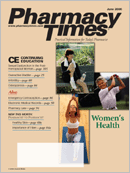Publication
Article
Pharmacy Times
New Option: Inhaled Insulin
Author(s):
The recent approval of humaninsulin inhalation powder (Exubera)by the FDA creates a newtherapeutic option for people with type 1and type 2 diabetes. The drug is the firstinhaled, noninjectable insulin option availablein the United States. The approvalwas based on studies of more than 2500patients who were enrolled for 12 weeksto 6 months. The results of the studiesshowed that inhaled insulin was as effectiveas short-acting injectable insulin forachieving glycemic control in adults withtype 1 and type 2 diabetes. Addition ofinhaled insulin to oral medications in type2 diabetes also resulted in better glucosecontrol in patients who were poorly controlledon oral agents alone.1-3
Inhaled insulin has a duration of activitythat is similar to injectable regularinsulin but has an onset of action that issimilar to rapid-acting insulin analogs.Pharmacokinetic studies demonstratedpeak insulin levels at an average of 49minutes for inhaled insulin versus 105minutes with regular insulin.4,5 The drugis dosed at 0.05 mg/kg, rounded down tothe nearest milligram. Patients shouldadminister inhaled insulin 10 minutesprior to meals using the appropriatecombination of 1-and 3-mg unit dosesthat equal their calculated dose. Inhaledinsulin should be administered only withthe inhaler that is provided with theproduct, and any other inhaled medicationsshould be administered before theinsulin. Three 1-mg doses cannot be substitutedfor the 3-mg capsule. Doing soresults in an insulin exposure that is 30%to 40% higher than that of the 1-and 3-mg combination. Patients with type 1diabetes should use inhaled insulin incombination with long-acting injectableinsulin. Patients with type 2 diabetes mayuse the product as monotherapy or incombination with oral agents.
The potential for inhaled insulin tocause long-term respiratory problems isa concern that delayed approval of theproduct in the United States. The proposedmechanism of damage is longterminhalation and deposition of proteinon the lung surface. Recent short-termstudies have not shown any clinically significantchanges in lung function, however.1-4 Use of the inhaled product is notrecommended in patients who havechronic lung diseases (asthma, bronchitis,or emphysema). It is contraindicatedin patients with poorly controlled orunstable lung disease, because variationsin lung function can affect absorptionand increase the risk for hypoglycemiaor hyperglycemia. Blood glucoseshould be monitored closely duringrespiratory illnesses that occur whileinhaled insulin is being used. The manufacturerrecommends baseline lungfunction tests (LFTs) at the beginning oftreatment. A small, clinically insignificantdecrease in lung function may occur inthe first few months of treatment, soLFTs should be repeated at 6 months oftherapy. If test results are stable, LFTsmay be repeated annually. Patients whohave a decline of 20% or more frombaseline forced expiratory volume in 1second should discontinue treatment.5Long-term postmarketing studies will beconducted to further investigate effectson lung function.
Other concerns exist with the use ofinhaled insulin related to precision ofdosing, when compared with injectionand induction of antibodies to insulinwhen it comes in contact with the lungsurface. Comorbidities, smoking status,and administration technique have thepotential to greatly affect exposure tothe drug and possibly the clinical resultsachieved with the new formulation.Injection of insulin minimizes variationseen in insulin levels, but many patientsare afraid of injections and the possibilityof hypoglycemia and will refuse to useinjectable insulin. With respect to antibodydevelopment, studies demonstrateda 28-fold increase in antibodies duringtreatment, but this increase did nottranslate into changes in plasma glucoseor duration of action of inhaled insulinwhen compared with the subcutaneousinjection of insulin.6
Inhaled insulin is contraindicated forpatients who smoke or who have quitsmoking in the past 6 months. A study ofpharmacokinetics in smokers concludedthat the time to maximum concentrationof insulin and the area under the curve(AUC) for smokers were higher, greatlyincreasing the risk of hypoglycemia.7These 2 parameters were unaffected bysmoking when subcutaneous insulin wasused. After the cessation of smoking, theAUC of inhaled insulin decreased by 50%within 1 week. Resumption of smokingcompletely reversed the effects of smokingcessation. Treatment should be discontinuedin patients who start orresume smoking because of this risk.
Adverse events associated withinhaled insulin are generally mild to moderate.Some patients may experiencecoughing after product inhalation, butthese episodes tend to improve as treatmentcontinues. Other than cough, hypoglycemia,dyspnea, sore throat, and drymouth were the most commonly reportedside effects.
Dr. Garrett is a clinical pharmacistpractitioner at Cornerstone HealthCare in High Point, NC.
For a list of references, send astamped, self-addressed envelope to:References Department, Attn. A. Stahl,Pharmacy Times, 241 Forsgate Drive,Jamesburg, NJ 08831; or send an e-mailrequest to: [email protected].

Newsletter
Stay informed on drug updates, treatment guidelines, and pharmacy practice trends—subscribe to Pharmacy Times for weekly clinical insights.






